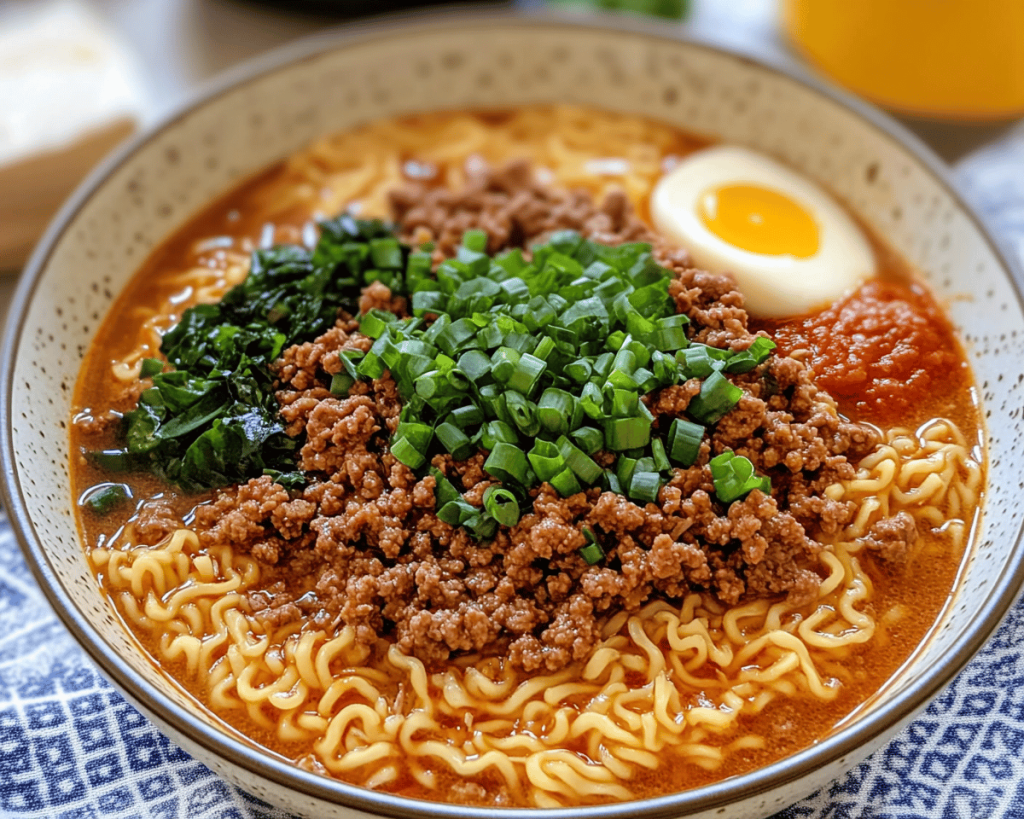I remember the first time I made Korean-Style Ground Beef Ramen; it was one of those rare, rainy afternoons when the world outside felt like a watercolor painting—soft and blurred. I had just come home from a long day at work, and honestly, all I wanted was something warm and comforting. So, I rummaged through my pantry and fridge, grabbed whatever ingredients caught my eye, and thought, “Why not mix Korean flavors with a classic comfort food?” I mean, ramen always felt like a blank canvas, didn’t it? You could add just about anything and make it your own.
The result was a glorious, steaming bowl of ramen that warmed not just my belly but my soul, too. The savory ground beef mingled beautifully with a rich broth that had a delightful kick thanks to some gochujang and soy sauce. That first spoonful felt like being wrapped in a cozy blanket. I knew I had stumbled upon something special. And you know what? It was so simple! I couldn’t believe how easy it was to whip up. Now, every time the weather turns dreary or I just want to indulge in a bowl of happiness, this is my go-to recipe. It’s become more than just sustenance; it’s a little moment of joy in my day.
Oh, and the beauty of it? You can adapt it however you like! Whether you want to toss in some extra veggies, or swap out proteins, it’s all good. I always find it fascinating how food evolves for each person; it’s kind of like our unique fingerprints showing up in our cooking, right?
So, grab a comfy seat and let’s dive into everything you need to know about this bowl of deliciousness.
What Goes Into Korean-Style Ground Beef Ramen?
Let’s break down the ingredients together. Each element plays a vital role in this recipe, so let’s appreciate them one by one.
– **Ramen Noodles**: Okay, here’s a little confession—I use the instant kind most of the time. Yes, they’re quick and easy! Plus, they come with that delightful little seasoning packet, although I usually toss that aside and use my own mix. If you feel like going the extra mile, fresh ramen noodles are absolutely fantastic.
– **Ground Beef**: I adore using **ground beef** because it cooks quickly and adds a wonderful richness to the broth. Not to mention it soaks up all those gorgeous flavors. If you happen to have leftover bulgogi, you can use that instead. That’s a delicious way to switch things up and honor those leftovers. Sometimes, I even add a splash more of sesame oil if I have it!
– **Gochujang**: This **Korean chili paste** is like magic in a jar. It brings a sweet, spicy tang that elevates the whole dish. If you’re not feeling super adventurous, you can start with just a teaspoon and add more gradually; I promise the magic is worth it.
– **Soy Sauce**: This is a must for that umami punch! I opt for low-sodium soy sauce so I can control the saltiness, but again, no hard rules—just go with what you like.
– **Garlic and Ginger**: I can’t really imagine this recipe without freshly minced **garlic** and a bit of **ginger**. Their smells mingling together as they sauté is one of the best culinary perfumes around. Honestly, I often grate the ginger because it mixes so smoothly into the sauce.
– **Green Onions**: These little pops of flavor add brightness to the finished dish. I like to slice them thinly and save some for garnishing, of course. A little fresh crunch goes a long way!
– **Eggs**: A softly poached or just barely boiled egg makes this dish feel extra special and so comforting. The rich yolk creates a creamy texture when you cut into it that I just can’t resist.
– **Cabbage or Spinach**: This is my little way of sneaking in some greens. Plus, they cook down beautifully in the broth, if you’re trying to be a tad healthy. No judgment here if you skip it though—it’s your bowl of deliciousness!
– **Sesame Oil**: Just a drizzle at the end really brings all the flavors together. It’s that finishing touch that makes the dish sing with warmth.
You know what I mean? Each ingredient plays off the other, and that’s what I love most about cooking. It’s collaborative magic.
Is Korean-Style Ground Beef Ramen Actually Good for You?
Okay, let’s get real for a moment. This isn’t a “health food,” but it’s far from being the villain, either! Sure, it’s rich and comforting, which means it’s a nice indulgence. But let’s take a look at the ingredients:
– **Ground Beef** is a great source of protein and iron, which can keep you feeling full and satisfied. If you’re looking to lighten it up, you can easily substitute it with ground turkey or chicken—it’s all good.
– **Gochujang** contains fermented soybeans and offers a little bit of antioxidant love. Moderate use keeps it flavorful but not crazy spicy.
– **Garlic** and **ginger** are fantastic anti-inflammatory ingredients that can do wonders for your health. The more flavor the better, right?
– **Spinach** or **cabbage** add some necessary fiber, making your dish not just delicious but more balanced.
With all that said, I wouldn’t call it a “diet” meal by any means! But here’s the thing: food is about balance, and pleasure matters just as much as nutrition. This dish brings joy and warmth, and I think that’s incredibly important.
Here’s What You’ll Need
– **2 packs instant ramen noodles** (serves 4)
– **1 lb ground beef**
– **2 tablespoons gochujang**
– **2 tablespoons soy sauce**
– **3 cloves garlic, minced**
– **1 inch ginger, grated**
– **4 green onions, chopped** (1 for sautéing, 3 for garnish)
– **2 cups cabbage or spinach** (or both if you’re feeling fancy!)
– **2 eggs**
– **1 tablespoon sesame oil**
– **4 cups beef or chicken broth** (or even water)
Here’s the thing: feel free to adjust the ingredients according to what you have. That’s the beauty of home cooking! Sometimes, I even toss in carrots or mushrooms if they’re hanging around in the fridge. You do you!
How to Make Korean-Style Ground Beef Ramen Step-by-Step
Alright, my friend, let’s dive into the steps. Grab your apron and let’s get cooking!
1. **Prep Everything First**: Chop your garlic, ginger, and green onions. I’m a big fan of having everything ready to go before starting. No last-minute chopping when you’re stirring a bubbling pot, you know?
2. **Cook the Beef**: In a large pot, over medium-high heat, toss in the ground beef. Use a wooden spoon or spatula to break it up as it cooks. Here’s where that rich aroma starts filling up your kitchen. It’s like a hug in the air!
3. **Season It Up**: Once the beef is almost cooked through (we’re talking no longer pink), add in the garlic, ginger, and that glorious gochujang. Mix it all together well—it should be looking vibrant and delicious. Now, pour in the soy sauce and stir until everything is combined. If you want to elevate the flavor even more, let it sauté for another minute. Yes, please!
4. **Add the Broth**: Pour in the broth and bring it to a simmer. Go ahead, taste it. If it’s not quite right, feel free to adjust the soy sauce or gochujang as needed. You want it to resonate with your palate, not a salt-licked soup. In about five minutes, it’ll start bubbling nicely.
5. **Cook the Noodles**: Toss the instant ramen noodles into the pot. They only need about 3-4 minutes to cook, depending on how you like them. I personally enjoy them slightly chewy, but you do you!
6. **Throw in the Greens**: Stir in your cabbage or spinach and give it a minute to wilt down. I usually add it right at the end so it retains some crispness. There’s something so satisfying about that mix of textures.
7. **Poach the Eggs**: While that soup is simmering, I like to poach my eggs separately. In a small pot, bring some water to a light boil, then crack in the eggs gently—let them cook for about 3-4 minutes. You want the yolk to be runny but the whites set. Pure magic.
8. **Plate It Up**: Once those noodles and greens are perfectly cooked and infused, ladle the ramen into bowls. Top each one with a poached egg, a drizzle of sesame oil, and sprinkle those chopped green onions all over.
9. **Dive In!**: I mean, you really should settle in with a big spoon and dig right in. You’ll know you’ve succeeded when that first bite makes you sigh in contentment.
This is where you can also put on your personal chef hat and rearrange the toppings if you like. Honestly, there’s no wrong way to enjoy it.
Little Extras I’ve Learned Along the Way
I can’t help but share a few tricks I’ve picked up through the years while making this dish:
– **Bulk Up on Veggies**: If you want to sneak in more veggies, think about adding bell peppers, zucchini, or even mushrooms. Freeze them for a busy night; no one will judge you!
– **Ramen Party**: Sometimes, I invite friends over, and we all bring something to toss into the ramen. It transforms into an amazing potluck! Seriously, you’ll be surprised what works.
– **Storage**: This makes fantastic leftovers, but if you know you’re going to have leftovers, store the noodles separately. They tend to get mushy if they sit in the broth. It’s just a tip; you don’t want to be chomping on a noodle mush flashback.
– **Spicy Lovers Club**: Add some fresh sliced chilies if you want more heat. You can also sprinkle some chili flakes or sesame seeds on top right before serving for a lovely crunch. Just make sure to warn your guests if they’re not into ‘hot.’
– **Experimenting with Stock**: The broth can make or break it. If you want to experiment a little more, swap half beef broth with coconut milk for a creamy twist—it’s surprisingly delightful!
This recipe has officially become one of my family’s favorites, too. Whether it’s a cozy weeknight or a weekend when you just want to indulge, I promise you’ll fall in love with this bowl of simple happiness. And you can customize it every single time to suit your mood or what’s lingering in your fridge.
So, what do you say? Give it a whirl? This one means a lot to me. I’d love to hear how yours turns out or any twists you decide to throw in. Happy cooking!



